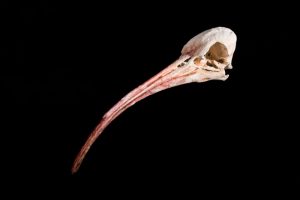Nice, nice. I’ve lost my connecting flight and now i’m stuck in Madrid Barajas waiting for the next flight to Sevilla. It’s an 8 hour wait but i’m on my way to ZEMOS98 so i am still cheerful.
Anyway, gives me plenty of time to catch up with the emails and the long overdue posts. So back to New York where i was a few days ago and the Exit Art gallery. I’m still wondering how this place managed to escape my radar so far.

Until April 19 they are running a fascinating exhibition on artistic explorations of the current advancements in neurological research. The works shown in BRAINWAVE: Common Senses encourage visitors to consider the brain not only as the center of human activity but as a site for interpretation, for scientific and philosophical debates, for examining our relationship to the world – and for questioning our common sense.
I am usually not very excited by media art works which engage with the little grey cells. Blame it on the BrainBar, when i discovered it i somehow felt that had seen it all. Well, maybe not… I went to Exit Art to see Fernando Orellana and Brendan Burns’ robot that “plays back dreams” which was twice as fantastic as i expected but i also discovered 2 or 3 outstanding works.
Suzanne Anker‘s fascinating and elegant The Butterfly in the Brain uses three-dimensional Rorschach inkblot tests, brain scans and images of butterfly wings to explores the imagery of the symmetrical (or virtually symmetrical) structures of butterflies, the brain, and chromosomes.
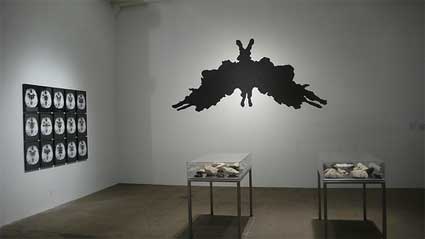
I somehow can’t get the black hovering butterfly bat she painted on the wall out of my mind. “By taking the butterfly bat image out of a textbook, scaling it up to a large size, and putting it in a site-specific environment, one turns the image into an entirely new and other kind of affective entity,” she explained.
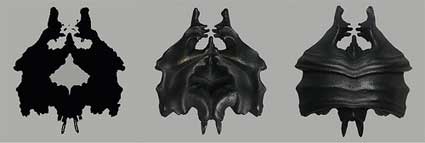 Suzanne Anker, The Sum of All Fears (detail). Image courtesy of the Exit Art gallery
Suzanne Anker, The Sum of All Fears (detail). Image courtesy of the Exit Art gallery
Although the use of Rorschach inkblots is controversial in psychology, the images are widely recognized among the public.
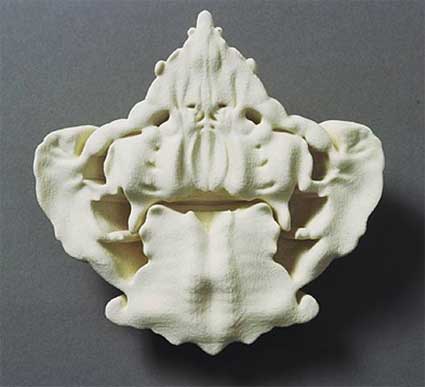 Crab, 2005
Crab, 2005
Anker used a computer program to convert an inkblot into 3D structure so intricate they could probably not be re-created using traditional sculpture. After which a machine produces the object using plaster and resin. “Looking in 3-D,” Anker argued, “one begins to assess new meanings: bones, sea creatures, body parts. These are surrogates for the imagination itself, opening up a dialog between the mind and body. What happens when you can pick up a psychology test in your hand? The mind essentially has been embodied.”
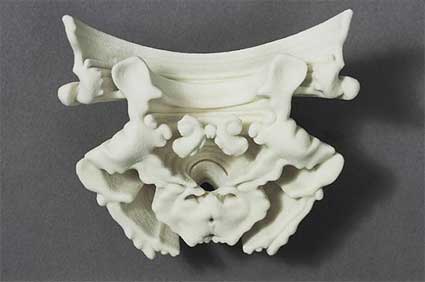 Gossipers, 2005 (more images)
Gossipers, 2005 (more images)
She also transposed butterfly wings onto MRI scans, drawing a parallel between genetic patterns in nature and advanced imaging technologies. Like constellations in the sky, butterfly shapes may be found in neurological maps as well as charts of urban sprawl.
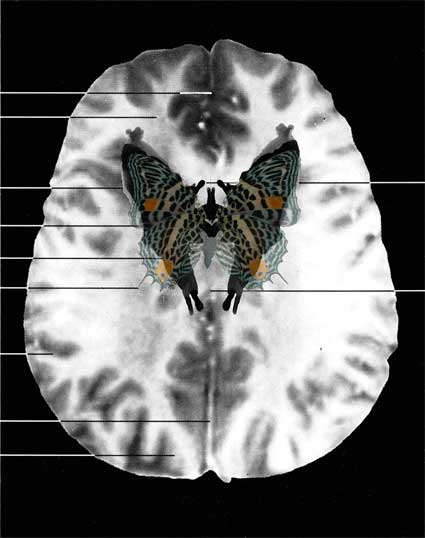 Suzanne Anker, MRI Butterfly (detail). Image courtesy of the Exit Art gallery
Suzanne Anker, MRI Butterfly (detail). Image courtesy of the Exit Art gallery
Another work i found really moving and riveting was a video installation by Phil Buehler, a photographer, fascinated by “haunted ruins” of abandoned Psychiatric Hospitals.
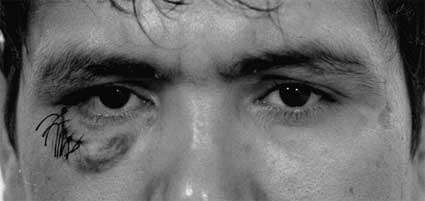 Buehler, Windows of the Soul. Image courtesy of the Exit Art gallery
Buehler, Windows of the Soul. Image courtesy of the Exit Art gallery
Windows of the Soul, asks whether or not one can read madness in another’s eyes. 300 b&w mug shot photographs of mental patients, taken in the ’50s when they were admitted in the hospital. The eyes of the individuals are projected on a canvas hanging from the ceiling. The rest of the face lays on the floor. Every 5 seconds, another pair of eyes and a face take their place on the split screen. Riveting and disturbing.
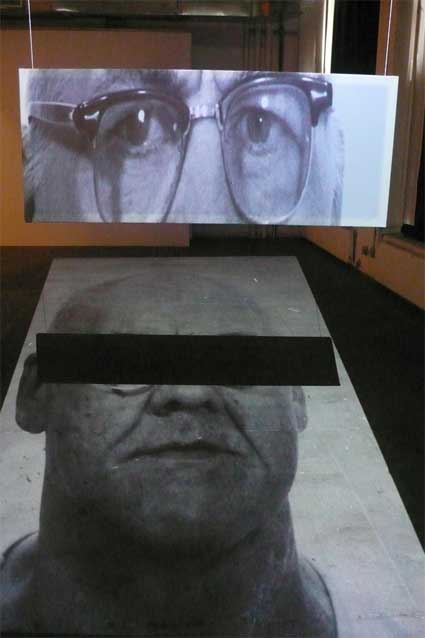 Dustin Wenzel‘s brass sculptures are brain-cavity castings of Great Whales from the New Brunswick Museum collection.
Dustin Wenzel‘s brass sculptures are brain-cavity castings of Great Whales from the New Brunswick Museum collection.
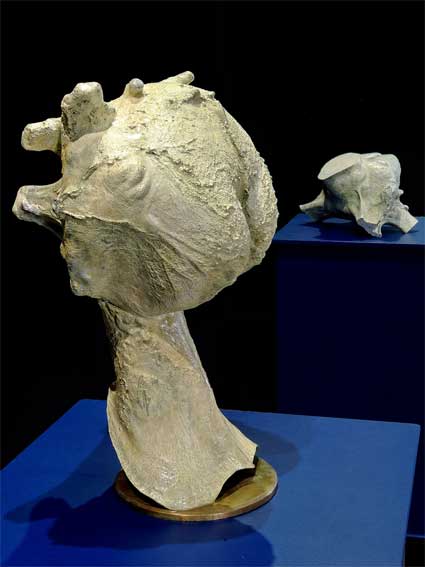 Dustin Wenzel, (front) Sperm Whale Endocranial Cast, (back) Right Whale Endocranial Cast. Image courtesy of Exit Art Gallery
Dustin Wenzel, (front) Sperm Whale Endocranial Cast, (back) Right Whale Endocranial Cast. Image courtesy of Exit Art Gallery
It has recently been discovered that some humpback whales have spindle neurons, a type of brain cell previously considered to exist only in dolphins, humans and other primates, which may indicate a high capacity for intelligence. Although white males possess the largest physical brain of any animals (Wenzel’s castings were indeed impressively big), there is no scientific consensus about the nature, magnitude or even existence of cetacean intelligence.
And now for the gizmos:
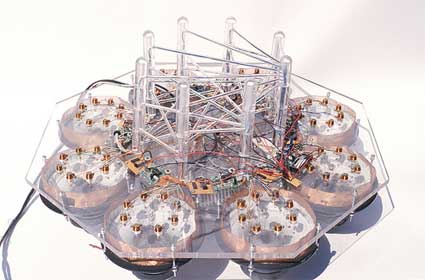 Jamie O’Shea, Alvin (image courtesy of Exit Art gallery)
Jamie O’Shea, Alvin (image courtesy of Exit Art gallery)
Artificial neural networks are often used in voice recognition systems and IA research. They consist in mathematical computations that mimic the neural network patterns of the nervous system. Jamie O’Shea‘s Alvin is a realization of an interactive and electronic neural network constructed with physical hardware. When left alone Alvin is dormant, but if you the lay your hand on the interface provided, you will set an electronic neural-like network in motion.
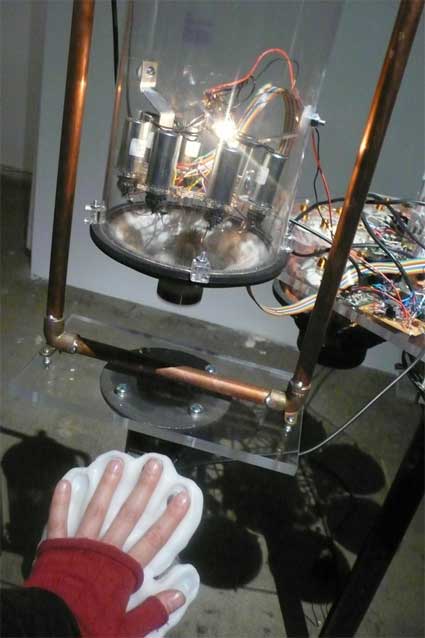
Alvin is a cellular automaton organized around eight cells which produce sound. The sound one cell produces is determined by what sound the other cells are making. This interrelated input and output scheme is an artificial neural network; a simulation of a brain. The imitation of life goes even further, because Alvin’s sound circuits are built and destroyed by one another, rather than just turned on or off.
Swarm, by David Bowen (whom i interviewed a year ago), is an autonomous roaming device whose movements are determined by houseflies housed inside the device itself.
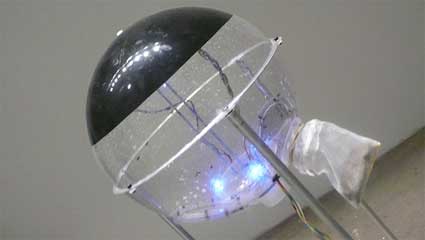 David Bowen, Swarm (detail). Image courtesy of Exit Art Gallery
David Bowen, Swarm (detail). Image courtesy of Exit Art Gallery
The chamber where they live contains food, water and light to keep them warm but also sensors that detect the changing light patterns produced by their movements. The sensors send the light data to an on-board microcontroller, which in turn activate the motors moving the device in relation to the movements of the flies.
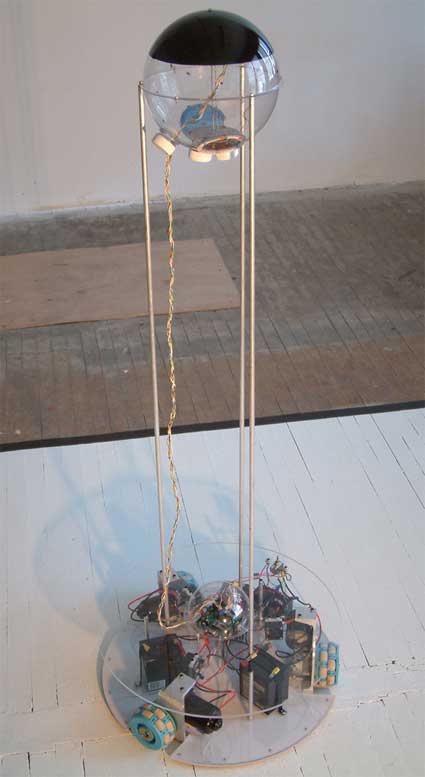 David Bowen, Swarm. Image courtesy of Exit Art Gallery
David Bowen, Swarm. Image courtesy of Exit Art Gallery
Oh, look! i took all those little images.
BRAINWAVE: Common Senses is on view until April 19, 2008 at Exit Art Gallery in New York. This exhibition is part of Exit Art’s Unknown Territories series of exhibitions that explore the impact of scientific advances on contemporary culture and examine in particular how contemporary artists interpret and interact with the new knowledge and possibilities created by technological innovation in the 21st century.

